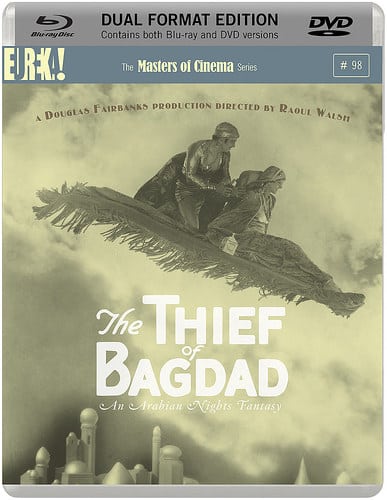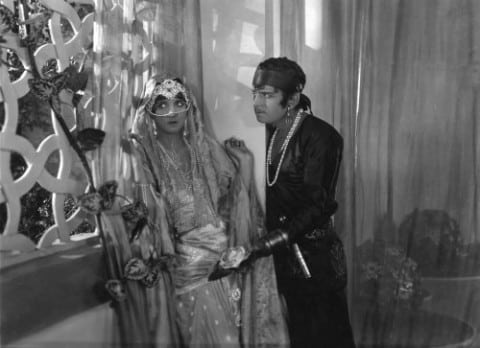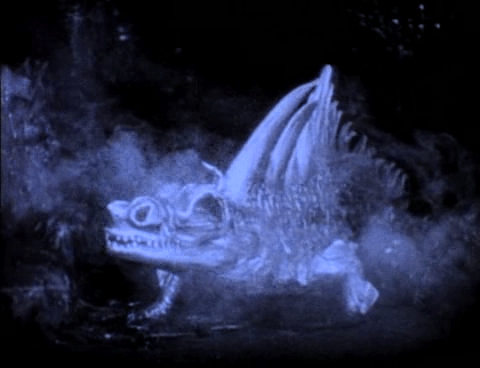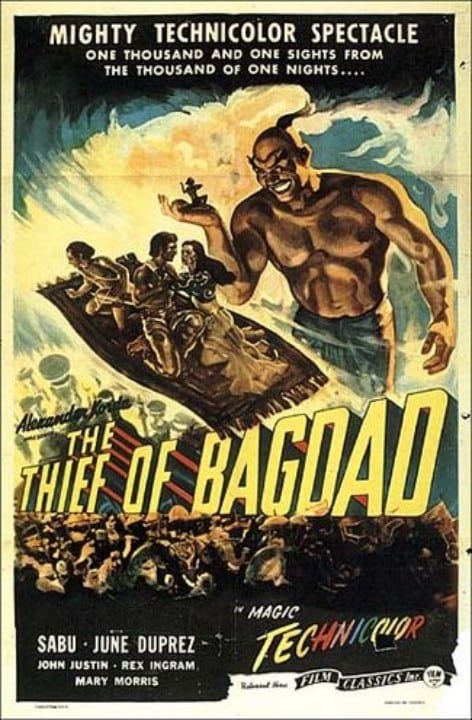The Thief Of Bagdad (1924)
Directed by: Raoul Walsh
Written by: Achmed Abdullah, Douglas Fairbanks, James T. O'Donohoe, Lotta Woods
Starring: Charles Belcher, Douglas Fairbanks, Julanne Johnston, Sôjin Kamiyama
HCF REWIND NO. 223: THE THIEF OF BAGDAD [USA 1924]
AVAILABLE ON DUAL FORMAT BLU-RAY AND DVD: from EUREKA ENTERTAINMENT
RUNNING TIME: 155 min
REVIEWED BY: Dr Lenera, Official HCF Critic
Ahmed leads a carefree existence robbing in the city of Baghdad. One night, he sneaks into the palace of the Caliph using a magic rope he stole during ritual prayers. All thoughts of plunder are forgotten when he sees the sleeping Princess, the caliph’s daughter. The princess’s Mongol slave discovers him and alerts the guards, but he gets away. When his associate reminds the disconsolate Ahmed that a bygone thief once stole another princess, Ahmed sets out to do the same. The next day is the Princess’s birthday. Three princes arrive, seeking her hand in marriage and the future inheritance of the city. Ahmed appears, disguised in disguised in stolen garments as a suitor, and his horse tosses its rider into it. Meanwhile, one of the other suitors, the Mongol Prince, is plotting to take over Bagdad….
The Arabian Nights have been quite a fertile source for filmmakers over the decades, and I’m a big fan of Ray Harryhausen’s three Sinbad adventures, but the two greatest movies set in this world to me are both entitled The Thief Of Bagdad. There have actually been six official adaptations of this story, and at least two unofficial ones [Arabian Adventure and Disney’s Aladdin]. Most writers about old cinemas claim the 1940 version is the best, and it certainly is a wondrous experience, while it’s probably easier to delve into for most modern viewers who are a bit daunted by the idea of watching a long silent movie. For me though, this 1924 version is the best one, though both pictures are classics and it’s a closely-run thing. This original version is a simply extraordinary fantasy movie which must have really blown the minds of 20’s viewers and is still staggering in its scale, its ambition, its inventiveness, and its beauty. Watching the film again for this review, it struck me that not only was it the Lord Of The Rings of its time [and actually Fritz Lang’s Die Nibelungen can probably more lay claim to that title], but that movies like this haven’t really changed that much. The Thief Of Bagdad has it all: lavish special effects, thrilling action scenes, unbridled imagination – you name it, not to mention the biggest movie star of its time at his best.
Achmed Abdullah, actually a pseudonym of the Russian writer Alexander Nicholayevitch Romanoff, is often credited with writing the novel The Thief Of Bagdad the films are based on. He did, but after he had collaborated on the screenplay with star Douglas Fairbanks and Lotta Woods. Intending to make a sequel to The Mark Of Zorro, Fairbanks stayed up all night reading One Thousand And One Nights, inspiring the swashbuckling star, who was given carte blanche to do what he wanted, to make an Arabian Nights picture. Inspired also perhaps by Die Nibelungen and definitely by the Persian segment of Lang’s Destiny, he planned a film which would be the artistic peak of his career. The sets, the main one still the biggest ever, covered six and a half acres and its large ‘Bagdad’ sign was visible to almost everyone in Hollywood, while every kind of special effect, and a couple of new ones, was utilised. The original female lead Evelyn Bent left the production a few weeks into it for mysterious reasons and was replaced by Julanne Johnson. As usual, the 41 year old did all his own stunts. Raoul Walsh was the director, though it’s generally regarded that Fairbanks really called the shots. Sadly the film was so expensive that there was no way it would recoup its cost, and was considered too over-the-top and extreme for 20’s tastes. It lost quite a bit of money, causing Fairbanks to lower his ambitions for his successive films, but it remained his favourite of his own pictures.
One of a handful of silent non-comedy films which were widely seen on TV, The Thief Of Bagdad was sometimes cut down, one version missing much footage from the middle, between the romance and the adventure portions of the film, and even some bits from the adventure including the underwater sequence. Of course it’s widely available uncut now and has been for decades, but as is common with silent films, prints can differ for other reasons. The original prints were colour tinted depending on the mood of a scene. When I first saw the film on TV, it was in a series of silent film restorations that had music by Carl Davis. For The Thief Of Bagdad, David adapted music by Rimsky-Korsakov, most of it from his wonderful Scheherazade Suite, and it seemed to go perfectly with the images, truly enhancing the splendour, the romance and the exoticism. Davis’s score is a perfect example of how to adapt ‘classical’ material for film, while of course the use of this particular material is appropriate anyway. Of course the original soundtrack to the film, which was actually one of the first silent films to have a full orchestral score of original material [by Mortimer Wilson], was different and some versions have recreated it, others haven’t [silent films often have many different scores], but in the process the Rimsky-Korsakov-scored version became harder to see and wasn’t available for a long time. Quite often the first version of a film you see will always be your favourite even if it’s not necessarily the most accurate one,and I wanted the Rimsky-Korsakov version damn it! Well, However, following on from the footsteps of Cohen Media in the US, Eureka Entertainment have released the Rimsky-Korsakov one. Hurray!!
“Happiness must be earned” is formed in the night sky by smoke at the beginning of the film as a man tells the story we are about to see to a boy on the outskirts of Bagdad, and yes there is a strong moral aspect to The Thief Of Bagdad that is hammered home. The early scenes show the existence of Ahmed, stealing anything he can. When he runs into a mosque, he tells the Holy Man (characters tend to not have actual names, just titles] he disdains his religion, his philosophy being: “What I want, I take.” His stealing of a bag leads to a chase where we are treated to two amazing little highlights: Fairbanks jumping in and out of several huge pots, and him climbing up a magical rope which can turn into a pole. He has an aide called the Evil Associate, though this character disappears from the film about an hour in. Sneaking into the palace to rob, he finds the sleeping Princess and changes his mind, though he does take her shoe. As in Disney’s Aladdin, the hero pretends to be a rich prince to impress the heroine, though this one still intends to steal her. This is probably the only really slow section in the film, and used to be the portion most often cut. Otherwise, though the action adventure may not start properly until just over half way, the first half is certainly not boring. It has one of the most purely romantic scenes in any film, where Ahmed tries to carry off the Princess – remember, what he wants, he takes – and can’t bring himself to do it and turns away, though she falls in love with him anyway. The use of the loveliest of the Scheherazade pieces really works well here in enhancing the simple poignancy of the scene.
Ahmed doesn’t entirely turn over a new leaf until he hears that the Princess will marry the one out of her suitors who brings her the rarest gift after seven moons. Here the film embarks on over an hour of incredible action adventure, throwing things at us in such quick succession that on a first viewing it’s hard to take everything in. There’s a cave of fire, a cave of monsters, an underwater kingdom full of nymphs, a tree man, a crystal ball which is an all-seeing eye, an apple which can cure anything [even death], a flying horse, a flying carpet, a cloak of invisibility – in fact the only thing not seen is a genie. The pace is truly relentless, though the monsters are slain rather too quickly, and of course Ahmed must also save the city, and his endangered loved one, from the evil Mongol Prince who also says: “What I want, I take”, leading to a delirious climax where Ahmed uses some magic powder to spring an army up from the ground. The only disappointments in this plethora of riches are that Fairbanks doesn’t give himself much of a chance to show his prowess with a sword like his previous few pictures [though the final showdown does interestingly revolve around brains more than brawn], and that the Mongol Prince’s aide, played in a deliciously evil but sexy manner by Anna May Wong, doesn’t get to contribute a whole lot.
Being that this is a film from 1924, you would expect many of the special effects to look a bit ropey, and some of them do, but there are so many of them, and they would have looked fabulous at the time, so it hardly matters. The man-in-suit dragon and giant bat look a bit poor but a large underwater spider [?] is rather creepy, while a big gorilla is simply a normal one placed alongside little people. The flying horse is obviously galloping on a surface and its wings are far too small, but the cloak of invisibility effect is good and the flying carpet, even if you occasionally see the wires, looks better than a lot of CGI stuff today. The carpet is actually there, a model in the distant shots, but for the close-ups, a real carpet was hoisted on a crane while a wind machine and speeding up of the camera simulated flight. Other effects are more deliberately strange, like the sea which is actually made up fabric. At times like this, the film achieves an almost transcendent beauty. The sets by William Cameron Menzies enhance the dreamlike feel. They don’t attempt to look like a real Arabic world, rather an Arabic world of fantasy. Floors are made of reflective glass so the city looks floating, objects, from a gong to flowerpots, are enlarged [ this also makes it more impressive when Douglas clambers over everything], and there’s as much art nouveau and art deco combined with the more Middle Eastern aspects in the design of this incredible fantasy world of the imagination. Perhaps the most striking set is an underwater kingdom where jelly fish chandeliers hang from the ceiling.
Some critics of the time said that Douglas was dwarfed by the sets, but I don’t think it was possible for anything to dwarf the larger-than-life screen personality of the star. His acting, even more than a lot of other silent film performers, seems extremely broad and almost pantomime-ish nowadays. For example, when he’s hungry, he rubs his stomach. Some of the other acting, for instance that by Sojin Kamiyama, who is very sinister as the very Fu Manchu-like Mongol Prince, dates much better. There’s no doubt though that Fairbanks virtually perfected this type of performing which seems almost alien to our modern eyes, and the man’s exuberance, charisma, not to mention his Jackie Chan-like physical dexterity, still makes him fabulous to watch, though the clear picture of the Blu-ray shows that his trousers are so tight they’re positively indecent. He’s given some almost amusingly poetic dialogue in the inter-titles, such as: “I can bear a thousand tortures, endure a thousand deaths, but not thy tears”, said by Ahmed when his beloved starts to weep. More amusing are some of the character introductions. The Mongol Prince is announced as: “ Cham Shang the Great, Prince of the Mongols, King of Ho Sho, Governor of Wah Hoo and the Island of Wak”.
All this does go with the over the top approach of the whole thing – in fact everything is over the top in this movie, a production which is big in every way, and is gloriously excessive from the sets to the story to the romance to the action, yet is also has immense beauty and heart, in a way making it almost the perfect blockbuster. It was made with care, by people who not only wanted to entertain and “wow” their audience, but also to give them something beautiful and special. The Thief Of Bagdad is an absolute treasure of a film, a gift to those who like to dream, as entertaining today as a silent film can be, and one of the greatest fantasy pictures of all time. Eureka Entertainment’s release of the film, with its fully restored picture, correct tinting and Davis/Rimsky-Korsakov score, is an essential purchase. Every time I watch this intoxicating film, I forget that it’s silent about ten minutes in. In fact it doesn’t even seem to need dialogue.
SPECIAL FEATURES:
• New high-definition 1080p presentation of the film on the Blu-ray
• Audio commentary by Fairbanks biographer Jeffrey Vance
• 40-page booklet including new and exclusive writing on Douglas Fairbanks and Raoul Walsh










Be the first to comment